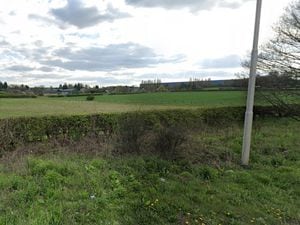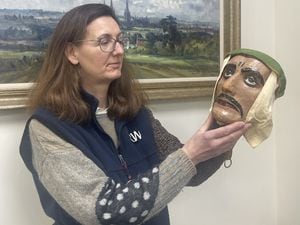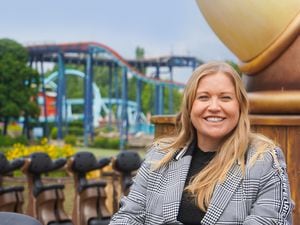JLR boss: We'll be in the Midlands for generations
The boss of Jaguar Land Rover's engine factory has a promise: "We are going to be here for generations".
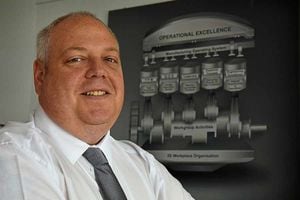
And Trevor Leeks revealed the company's £520 million investment in the most modern engine plant in the UK has so far created 1,000 jobs – the majority for people from the Black Country, Staffordshire and Shropshire.
Officially opened by Her Majesty The Queen in October, the factory started making engines for new cars earlier this year and hundreds are now rolling off the production line every day, ferried from the i54 site on the border between Wolverhampton and South Staffordshire, down the motorway to Solihull and installed in the new Jaguar XE saloons being made there.
Jaguar says it has already sold 2,900 of the new cars, which are the first to feature the Ingenium four-cylinder diesel engines made at Wolverhampton.
The engines are also due to start being installed in the revamped version of Jaguar's bigger XF executive saloon, which goes on sale in the autumn, the new Land Rover Discovery Sport and in the F-Pace Jaguar crossover – a mix of 4x4 and sporty estate car that will be unveiled to the world at the Frankfurt Motor Show in September.
Growing demand for the engines means work is continuing to ramp up a the site, which now employs around 700 JLR staff and another 300 working for contractors in roles such as cleaning, catering and security.
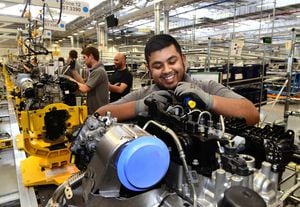
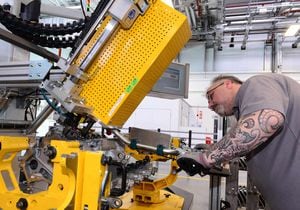
The site is a constant hive of activity. It's hundreds of car-parking spaces are mostly full and lorries are using the £44 million link road, completed last year, which directly connects the factory site to the M54, to deliver components and carry away the completed engines.
Among the thousands of components are the raw aluminium engine blocks, crankshafts and cylinder heads that are shaped and ground to precise measurements by the computer-controlled manufacturing machines.
Where possible, JLR says it has found suppliers for its parts and machinery in the UK but, inevitably, much of the kit in the machining hall comes from Germany.
The south facing hall is bright and surprisingly clean. Most of the machinery is white or light grey, adding to the brightness in the hall which is flooded with light from the south facing windows in its saw-tooth shaped roof.
The factory's 'smart' lighting system reacts to the amount of sunlight, coming on when the sky darkens. The ceiling is a maze of cables, conduits and pipework – all the power and water is carried there so it can be accessed without the need to dig holes in the floor.
Even after nearly a year of fairly constant use, that floor is still impressively clean, despite the amount of metal being processed through the 300 machines that operate in the hall.
JLR estimates machining work will generate around 3,000 tons of swarf and scrap metal every year, all of which goes for recycling. Some of it will probably come back, having been turned into engine parts.
Automation means most of the work in the machining hall needs minimal human supervision except for the maintenance teams who keep everything running smoothly,
The diesel assembly hall, where all the parts are brought together to actually make the engines, is a different matter. There are many more people working on the line, adding and fitting components, in what is a more 'hands-on' job.
It is still a hi-tech production line, however, with scores of robots supplied by Wednesbury-based Kuka as well as the automatic testing of each engine, once 'cold' and once 'hot' after ignition.
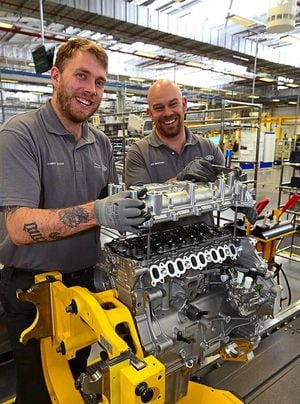
And one engine from each batch it taken out of the line at the end to undergo 'dyno' testing that can see it run for up to 300 hours non-stop. Not surprisingly, those engines go for recycling and not for use in a car anyone will ever drive.
As production increases, so the number of people working at the plant has increased. In just the last couple of months the number working in the diesel engine assembly hall has risen by around 50 to 180 on each of the two shifts.
And there is more to come. Work is already well under way preparing the third part of the factory, a petrol engine assembly hall, with the first test engines due to to come off the line "well before Christmas", says Trevor Leeks.
"That should be in full production by this time next year."
And, in addition to the new workers making petrol engines, the plant is planning for a third shift in its machining hall, which will then be working around the clock.
That will bring the site close to its promised target of 1,400 jobs created since work on the factory started just three years ago.
By that stage the EMC - Engine Manufacturing Centre – will extend to around 1 million square feet. And, when it hits top gear, Jaguar Land Rover expects the plant will be churning out an engine every 36 seconds.
For Tom Terry, Jaguar Land Rover holds the promise of a long-term career. The 23-year-old came out of the Army looking for the chance of learn a skill and, despite having no engineering qualifications, JLR picked him for one of their advanced apprentice positions.
Now in his second year, after gaining experience in each area of the Wolverhampton engine factory's machining hall, he has just started his training in the diesel assembly operation.
His enthusiasm for his new career is obvious: "I feel so lucky that I was able to get on the apprenticeship scheme. It's a privilege to work here. Every day is different, every day is a challenge."
Born and brought up in Pendeford, Tom joined the Household Cavalry at 16. He said: "I was in for five years, serving in a combat role. When I came out I wanted a trade. I wanted to improve myself and get a career."
JLR has a policy of recruiting from the Armed Forces and offered Tom a place. He's never looked back: "It's fantastic. I did my first year at Wolverhampton College, at Paget Road, and then I've been working here. I'm just enjoying it so much."
Now living in Wednesfield with his partner, who works at a car dealership, Tom said that when he was at school – he is a former pupil of Aldersley High – apprenticeships were not seen as an option. "Apprenticeships now are brilliant. I am on a three-year course but they have just announced they are going to extend them to four years in the future, with two years at college instead of one."
He is training to be a maintenance engineer – a vital role at a factory where much of the manufacturing is automated. The machine hall alone has around 300 machines in operation producing crankshafts, cylinder heads and cylinder blocks.
JLR has invested heavily in maintenance, with much of the emphasis on preventative work. Vibration analysis and infra-red examinations form part of the system aimed at keeping machinery working at full capacity.
"I'm getting a world class training working here," said Tom. "It means my locker is full of pamphlets, manuals and folders to help me keep up with all the new equipment that we have.
And JLR won't have finished then. It revealed earlier this year plans for another 900,000 sq ft factory that will sit next to the existing plant, with another 1,000 car-parking spaces.
JLR won't yet say what the next factory will be used for, but that could change in the next couple of months when it formally applies for planning permission. Work is due to start on the new building next year with JLR hoping to have it open by early 2017.
It is part of a massive investment programme at the company, owned by Indian parent Tata Motors, which is seeing £3.5 billion spent just this year on expanding its factories and developing new cars. Work is due to start on a new car plant in Brazil while another opened in China earlier this year to produce the company's hugely popular Range Rover Evoque.
Even with the expansion plans, JLR admitted earlier this summer that it is running out of capacity in its UK car plants, and struck a deal with Austrian company Magna Steyr to take on the manufacturing of some vehicles in the near future.
Trevor Leeks, who has been the operations director in charge of the engine factory since the start of 2014, says this places the plant at the heart of JLR's growth plans.
Progress at the engine factory has been consistently on track, he said, with the growing team hitting their targets in terms of "Job One", taking the huge plant for a series of empty halls to getting the Ingenium engines rolling off the line to coincide with production of the Jaguar XE at Solihull earlier this year.
"Next year will see production of the petrol engines," he said. The assembly hall is being prepared and is on target for the first couple of test engines to be assembled on the track before Christmas.
The engine blocks, cylinder heads and crankshafts for these engines will also be produced in the machining hall. Mr Leeks said the flexibility built into the design of the Ingenium engines meant the parts for the petrol variant were substantially the same as for the diesel. "They will all be manufactured here on the same equipment. This was set up to be a flexible facility," he said.
A major benefit has been the £44m link road to the M54 beside the factory site, giving it immediate access to the motorway network and putting the engine plant within two hours driving distance of all JLR's three car plants, at Solihull, Castle Bromwich and Halewood of Merseyside.
While it is of benefit to the company, Mr Leeks said it also meant that the traffic to and from the plant was kept away from local residents, in particular on the Pendeford estate on the other side of Wobaston Road, which runs along the south of the i54.
While it is clear that engine production is in the hundreds every day, the company is reticent on the details. "At the moment we don't really talk about the volumes, but it is increasing as we are actually producing engines for the XE Jaguar at Solihull."
"As a result staff levels have increased in the last few months by several hundred. We are probably up to nearly 1,000 including contract staff. Over 700 are JLR colleagues and the vast majority of them are from the local area."
The company is investing heavily in training. The initial staff recruited to get the plant ready were all highly skilled, but, said Mr Leeks, recruitment was now concentrating on semi-skilled workers for the production line.
For JLR the engine factory is a long term project, said Mr Leeks. The company's planned investment of £520 million underlined that, he said; "We are going to be here for generations."
As part of its plan for the future, the company is also recruiting 10-15 apprentices ever year to to work at the plant and has invested heavily in training facilities. Manufacturing equipment in both the halls is specifically set aside for training both apprentices and the new recruits, some of whom have no previous engineering experience before joining JLR.
"You don't invest £520m just for a small period of time," said Mr Leeks. "We are investing for the future, creating careers for people, not just jobs for people. We are investing in their development, which is why we put everyone through a three to four week 'on-board' programme when they join us."
It is part of an ambition to "change the way engines are made", said Mr Leeks. Without going into details, he says much of this is involved in the new 'architecture' of the Ingenium engines, which are designed to be more flexible and adaptable.
Jaguar Land Rover is fitting the four cylinder engines into an increasing number of cars in its range, such as the latest version of the hugely popular Range Rover Evoque. But the company needs six and eight cylinder engines for its bigger Range Rover and Land Rover vehicles.
These are currently supplied from outside the company, but there is speculation that the Ingenium has been designed so that it can be expanded to meet JLR's demand for bigger engines. If that is the case, the company is keeping its plans a tightly guarded secret.
Whatever the long term plans for engine design, Mr Leeks has to keep one eye on the programme for expanding production at the engine plant while also remaining "laser focused" of the day-to-day operation of the plant. That has seen the factory move to two shift production in May, while the start of petrol engine production next year will mean a third shift starting at the machining hall to ensure the flow of parts for both assembly halls.
JLR's growth plans and its ambitions for greater sales – they are already closing in on the magic half million a year figure – means the future seems bright for the UK's newest and most modern engine factory, and for the hundreds of people working there.


